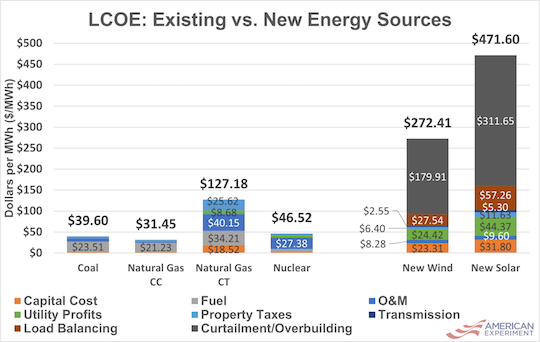We support our Publishers and Content Creators. You can view this story on their website by CLICKING HERE.
American Experiment’s Isaac Orr and Mitch Rolling tell you what you need to know to respond to ill-informed advocates for “green” energy. There is much more at the link, but here is an overview:
1. Renewables can’t survive on their own
The renewable energy industry is a subsidy-based industry, as wind and solar are largely dependent on lucrative state and federal subsidies. However, renewable advocates justify these perpetual subsidies by claiming thermal generators receive more subsidies than wind and solar. This assertion is not based on reality….
***
In 2022, wind and solar generators received three and eighteen times more subsidies per MWh, respectively, than natural gas, coal, and nuclear generators combined. Solar is the clear leader, receiving anywhere from $50 to $80 per MWh over the last five years, whereas wind is a distant second at $8 to $10 per MWh.
Poor solar energy! No matter how many billions the government pours down the solar rathole, no one has figured out a way to generate solar power after the sun goes down.
2. Renewables increase the cost of electricity
Renewable advocates often claim that the adoption of more wind and solar will lead to lower electricity costs, but the opposite is true. In a previous Substack, we wrote in detail about how utility companies with the largest rate increase requests in the country admit the energy transition is a major reason behind increasing electricity prices for families and businesses.
“Green” advocates fake the numbers for wind and solar by the simple expedient of only counting a fraction of their costs. This chart shows the actual cost of the various energy systems if all costs are included:

3. More wind and solar means more blackouts
Advocates of renewable energy also don’t want to account for one of the most damning facts about policies that favor wind and solar energy at the expense of dispatchable generators: that they have led to electricity blackouts in more than one region.
Greenies are full of bogus reasons why increased use of wind and solar are not to blame for blackouts, but they can’t answer the simple question: why is that we didn’t have blackouts before spending hundreds of billions on wind and solar, but now we do have blackouts?
Isaac and Mitch conclude:
Despite claiming to be ardent followers of “tHe ScIEncE,” wind and solar advocates live in their own universe of alternative facts that deny the basic physics and economics of the electric grid. Hopefully, this piece is useful for you the next time a wind or solar stan is arguing with you in the comments section.
One more “green” myth remains to be exploded: the claim that wind and solar are better for the environment than natural gas, nuclear and coal-fired electricity. That myth will be addressed in an upcoming report.

 Conservative
Conservative  Search
Search Trending
Trending Current News
Current News 




